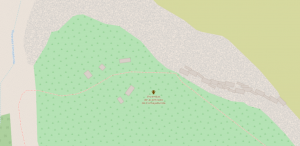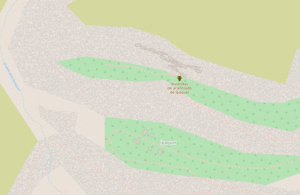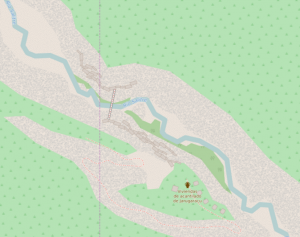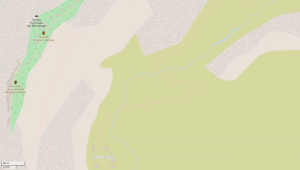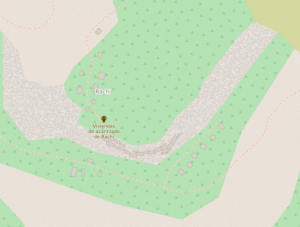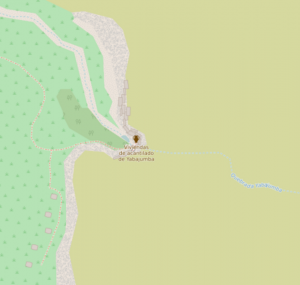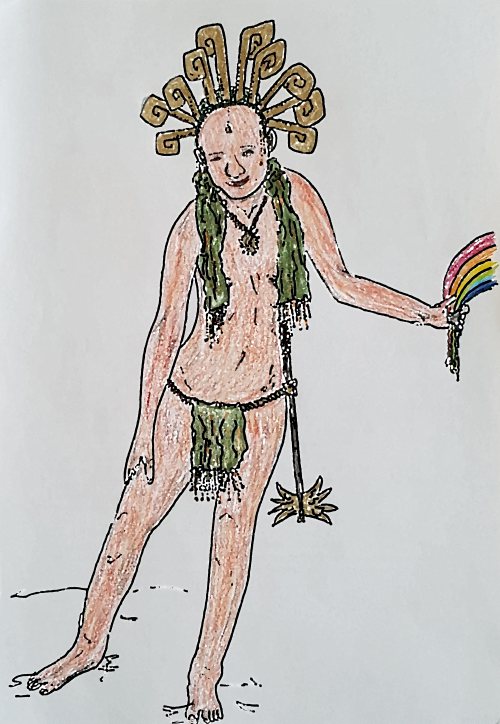Welcome to the geofictician wiki.
User:Luciano/Sandbox/Work-in-Progress/Comala
Geography
Historical Outline
Prehistory (before 200 BCE)
Archaic Period (200 BCE ~ 700 CE)
In the so-called "archaic period" (before the Tlönian Empire circa 800 CE), there was a group of people whom have not been clearly identified, but are assumed to have been ancestors or relatives of the modern Chemeco People, who in the modern era live in the southwest Ardisphere (mostly Departamento Occidental). These people built a number of settlements, often with complex cliff dwellings, in the canyonlands in the Comala Region.
They also placed tumuli (burial mounds) that were semi-pyramidal in shape, frequently on cliff ledges near their dwellings.
Comajadunda Cliff Dwellings
In the canyon of the west-flowing Arroyo Santa Solana, just east of the modern international boundary, there was a small cliff-dwelling settlement (map).
Ípaquel Cliff Dwellings
In the canyon of the Río Huracán, upriver from the Lago Agrio, there was a small cliff-dwelling settlement (map).
Jarugaracu Cliff Dwellings
In the very narrow canyon of the Río Salitre, there was a substantial cliff-dwelling settlement, which is unique among the the cliff-dwellings because they were on cliff faces on both sides of the river, which were connected by several rope bridges (map).
Querradanga Cliff Dwellings
In the Comala canyon of the Río de los Cartógrafos, there was a fairly major settlement called by the Altazorians, later, "Querrabanga" - the original name is unknown (map).
When the Tlönians arrived 500 years later, the cliff dwellings were abandoned. The Tlönians looted the burial mounds but left them more or less intact, building their main settlement farther downstream. This settlement was later taken over by the Altazorians during the post-classical period (1200 CE), but the Altazorians also re-occupied and somewhat modified the cliff dwellings, and dug a peculiar, complex network of caverns in the cliff face behind the old burial mounds, where they placed the bodies of a rather large number of ceremonially executed individuals. Thus when the Castellanese arrived, the cliff dwellings at Querrabanga were active.
In the modern era, the dwellings are partially restored to the Altazorian state, with those farthest south along the cliff face partially restored to the earlier archaic period.
Rachi Cliff Dwellings
On the north side of the valley of the Arroyo San Castiel, within view of the spectacular, columnar Torre Celestial, there was a medium-sized cliff-dwelling settlement (map).
Yabajumba Cliff Dwellings
In the canyon of the Quebrada Yabajumba, a small tributary of the Quebrada Tocino, upriver from the Río Rocarroja, there was a medium-sized cliff-dwelling settlement that was built on both sides of a very high waterfall. Yabajumba is the only set of cliff-dwellings that are in fact currently inhabited (map).
Tlönian Empire (700 CE ~ 1200 CE)
Quelepa
Named objects list for Quelepa
This list is mostly to help me keep track of all the names I'm making up for this project, and their meanings, and making sure they're being used and translated consistently. So this is a list of all names being used in the project. I don't know how to combine nodes, ways and relations into a single data set yet, so these are separate tables for nodes, ways and relations.
Nodes
- The following data has been retrieved from this URL, using the External Data MediaWiki extension.
Error while fetching data from URL https://osm3s.opengeofiction.net/api/interpreter?data=(node%5B%22name%22%5D%5B%22source%22=%22luciano_project_quelepa%22%5D;);out;: $2.
Error fetching URL: Could not resolve host: osm3s.opengeofiction.net
There was a problem during the HTTP request: 0 Error
Could not get URL https://osm3s.opengeofiction.net/api/interpreter?data=(node%5B%22name%22%5D%5B%22source%22=%22luciano_project_quelepa%22%5D;);out; after 3 tries.
| Name for Render | Castellanese | Ingerish | Quelepian | Map |
|---|
Ways
- The following data has been retrieved from this URL, using the External Data MediaWiki extension.
Could not get URL https://osm3s.opengeofiction.net/api/interpreter?data=(way%5B%22name%22%5D%5B%22source%22=%22luciano_project_quelepa%22%5D;);out; after 3 tries.
| Name for Render | Castellanese | Ingerish | Quelepian | Map |
|---|
Relations
- The following data has been retrieved from this URL, using the External Data MediaWiki extension.
Could not get URL https://osm3s.opengeofiction.net/api/interpreter?data=(rel%5B%22name%22%5D%5B%22source%22=%22luciano_project_quelepa%22%5D;);(._;%3E;);out; after 3 tries.
| Name for Render | Castellanese | Ingerish | Quelepian | Map |
|---|
The Story of Tlájaden and Pohöñe
Tlájaden was a Quelepian warrior princess who later became consort to the Tlönian Emperor, Pohöñe, and eventually became the reigning dowager Empress for the Empire at its height, making her hometown of Quelepa into a kind of "summer capital" for the Empire.
Tlájaden is a semi-legendary figure, and after her death she was deified and became associated with the rainbow cult and represented the "trickster" archetype in later stories.
Pohöñe is more of a tragic figure, having betrayed his first wife, Tlodolla, because of his love for Tlájaden. Tlodolla attempted to overthrow her husband but was defeated by Tlájaden. Later she murdered her former husband, but was unable to remove her rival from the throne. Tlodolla is associated with impotence and fruitless vengeance.
List of Temples with notes on affiliation
- The following data has been retrieved from this URL, using the External Data MediaWiki extension.
| Name | Note | Map
|
|---|---|---|
| Japa Cheboga (Templo de la Arenisca) | 'Cheboga' represents the Spirit of Justice, it is symbolized by 'Sandstone' | (node 62325686) |
| Japa Yuñe (Templo del Ojo Único) | 'Yuñe' represents the Spirit of Jealousy, it is symbolized by 'One eye' | (node 62325687) |
| Japa Goñaraja (Templo de la Rana) | 'Goñaraja' represents the Spirit of Insanity, it is symbolized by 'Frog' | (node 62325688) |
| Japa Sihún (Templo del Bebé) | 'Sihún' represents the Spirit of Innocence, it is symbolized by 'Infant Child' | (node 62325689) |
| Japa Sonirán (Templo de la Botella) | 'Sonirán' represents the Spirit of Inebriation, it is symbolized by 'Bottle' | (node 62325690) |
| Japa Goñamoña (Templo del Gorila) | 'Goñamoña' represents the Spirit of Indomitability, it is symbolized by 'Gorilla' | (node 62325691) |
| Japa Duhuña (Templo del Águila) | 'Duhuña' represents the Spirit of Impartiality, it is symbolized by 'Eagle' | (node 62325692) |
| Japa Ajumba (Templo del Dragón) | 'Ajumba' represents the Spirit of Immortality, it is symbolized by 'Dragon' | (node 62325693) |
| Japa Huanachilasa (Templo del Pez) | 'Huanachilasa' represents the Spirit of Ignorance, it is symbolized by 'Fish' | (node 62325694) |
| Japa Dumachomba (Templo de la Torre) | 'Dumachomba' represents the Spirit of Hubris, it is symbolized by 'Tower' | (node 62325695) |
| Japa Juañeboda (Templo del Palo) | 'Juañeboda' represents the Spirit of Herding Animals, it is symbolized by 'Staff' | (node 62325696) |
| Japa Andojón (Templo de la Medicina) | 'Andojón' represents the Spirit of Healing, it is symbolized by 'Medicine' | (node 62325697) |
| Japa Hagasamuha (Templo del Perro) | 'Hagasamuha' represents the Spirit of Guilt, it is symbolized by 'Dog' | (node 62325698) |
| Japa Sóñamel (Templo de la Lluvia) | 'Sóñamel' represents the Spirit of Growth, it is symbolized by 'Rain' | (node 62325699) |
| Japa Jeo (Templo del Alacrán) | 'Jeo' represents the Spirit of Grief, it is symbolized by 'Scorpion' | (node 62325700) |
| Japa Magojoño (Templo del Pollo) | 'Magojoño' represents the Spirit of Greed, it is symbolized by 'Chicken' | (node 62325701) |
| Japa Soyaña (Templo de la Pirámide) | 'Soyaña' represents the Spirit of Grace, it is symbolized by 'Pyramid' | (node 62325702) |
| Japa Goñahuajén (Templo del Collar) | 'Goñahuajén' represents the Spirit of Flirtatiousness, it is symbolized by 'Necklace' | (node 62325703) |
| Japa Yañachú (Templo de las Flores) | 'Yañachú' represents the Spirit of Fertility, it is symbolized by 'Flowers' | (node 62325704) |
| Japa Godesú (Templo del Gato) | 'Godesú' represents the Spirit of Femininity, it is symbolized by 'Cat' | (node 62325705) |
| Japa Ugabosa (Templo de los Caminos) | 'Ugabosa' represents the Spirit of Estrangement, it is symbolized by 'Roads' | (node 62325706) |
| Japa Dobayomba (Templo de las Dos Lanzas) | 'Dobayomba' represents the Spirit of Duality, it is symbolized by 'Two Spears' | (node 62325707) |
| Japa Peñaquía (Templo de la Máscara) | 'Peñaquía' represents the Spirit of Dreams, it is symbolized by 'Mask' | (node 62325708) |
| Japa Doajoñe (Templo de la Tortuga) | 'Doajoñe' represents the Spirit of Diligence, it is symbolized by 'Turtle / Shovel' | (node 62325709) |
| Japa Yuhadán (Templo del Ornitorrinco) | 'Yuhadán' represents the Spirit of Deviance, it is symbolized by 'Platypus' | (node 62325710) |
| Japa Jejia (Templo del Gusano) | 'Jejia' represents the Spirit of Despair, it is symbolized by 'Worm' | (node 62325711) |
| Japa Bonesó (Templo del Ojo Cerrado) | 'Bonesó' represents the Spirit of Departure, it is symbolized by 'Evening Star (Venus) / Closed eye' | (node 62325712) |
| Japa Jempichoso (Templo del Suelo) | 'Jempichoso' represents the Spirit of Deference, it is symbolized by 'Soil' | (node 62325713) |
| Japa Rupañe (Templo de la Pared) | 'Rupañe' represents the Spirit of Defence, it is symbolized by 'Wall' | (node 62325714) |
| Japa Eguió (Templo de la Matraca) | 'Eguió' represents the Spirit of Defeat in Battle, it is symbolized by 'Rattle' | (node 62325715) |
| Japa Jotín (Templo del Hombre sin Cara) | 'Jotín' represents the Spirit of Deception, it is symbolized by 'No-faced man' | (node 62325716) |
| Japa Sogayoñe (Templo del Agua Estancada) | 'Sogayoñe' represents the Spirit of Decay, it is symbolized by 'Still water' | (node 62325717) |
| Japa Puga (Templo del Hueco) | 'Puga' represents the Spirit of Death, it is symbolized by 'Black Circle' | (node 62325718) |
| Japa Nohechohe (Templo del Grajo) | 'Nohechohe' represents the Spirit of Curiosity, it is symbolized by 'Raven' | (node 62325719) |
| Japa Tlajanga (Templo del Jardín) | 'Tlajanga' represents the Spirit of Cultivation, it is symbolized by 'Garden' | (node 62325720) |
| Japa Quindeguia (Templo de la Canasta) | 'Quindeguia' represents the Spirit of Craftsmanship, it is symbolized by 'Basket / Clay bowl' | (node 62325721) |
| Japa Chindala (Templo del Caballo) | 'Chindala' represents the Spirit of Control, it is symbolized by 'Horse' | (node 62325722) |
| Japa Nuñajía (Templo de las Ascuas) | 'Nuñajía' represents the Spirit of Conspiracy, it is symbolized by 'Embers' | (node 62325723) |
| Japa Yañiro (Templo del Leopardo) | 'Yañiro' represents the Spirit of Confusion, it is symbolized by 'Leopard' | (node 62325724) |
| Japa Baganga (Templo de la Rata) | 'Baganga' represents the Spirit of Compulsivity, it is symbolized by 'Rat' | (node 62325725) |
| Japa Bésor (Templo de la Pelota) | 'Bésor' represents the Spirit of Competitiveness, it is symbolized by 'Ball' | (node 62325726) |
| Japa Chajín (Templo del Reloj del Sol) | 'Chajín' represents the Spirit of Chaos, it is symbolized by 'Wind / Sundial' | (node 62325727) |
| Japa Sogasó (Templo de la Nariz) | 'Sogasó' represents the Spirit of Caution, it is symbolized by 'Nose' | (node 62325728) |
| Japa Jangasón (Templo de la Cebra) | 'Jangasón' represents the Spirit of Carelessness, it is symbolized by 'Zebra' | (node 62325729) |
| Japa Jañachunga (Templo de la Araña) | 'Jañachunga' represents the Spirit of Callousness, it is symbolized by 'Spider' | (node 62325730) |
| Japa Cahojoga (Templo del Pellejo) | 'Cahojoga' represents the Spirit of Butchery, it is symbolized by 'Animal skin' | (node 62325731) |
| Japa Guañanga (Templo del Cuchillo de Obsidiana) | 'Guañanga' represents the Spirit of Bravery, it is symbolized by 'Jupiter / Obsidian knife' | (node 62325732) |
| Japa Riri (Templo de la Soga) | 'Riri' represents the Spirit of Bondage, it is symbolized by 'Rope' | (node 62325733) |
| Japa Pahichó (Templo del Tambor) | 'Pahichó' represents the Spirit of Betrayal, it is symbolized by 'Flea / Drum' | (node 62325734) |
| Japa Huajónaga (Templo del Relámpago) | 'Huajónaga' represents the Spirit of Beginning, it is symbolized by 'Lightening' | (node 62325735) |
| Japa Jumedoñe (Templo del Topacio) | 'Jumedoñe' represents the Spirit of Beauty, it is symbolized by 'Saturn / Topaz' | (node 62325736) |
| Japa Jímiñe (Templo de la Maza) | 'Jímiñe' represents the Spirit of Anger, it is symbolized by 'Thunder / Club' | (node 62325737) |
| Japa Gubuñe (Templo del Ala) | 'Gubuñe' represents the Spirit of Ambition, it is symbolized by 'Wing' | (node 62325738) |
| Japa Acahuaja (Templo del Silbato) | 'Acahuaja' represents the Spirit of Alertness, it is symbolized by 'Whistle' | (node 62325739) |
| Japa Jañachumba (Templo de la Pluma) | 'Jañachumba' represents the Spirit of Agility, it is symbolized by 'Feather' | (node 62325740) |
| Japa Moagán (Templo del Asta) | 'Moagán' represents the Spirit of Youth, it is symbolized by 'Young trees / Polearm' | (node 62325741) |
| Japa Yanga (Templo del Gavilán) | 'Yanga' represents the Spirit of Wealth, it is symbolized by 'Sparrowhawk / Counting stones' | (node 62325742) |
| Japa Soñechoña (Templo del Abanico) | 'Soñechoña' represents the Spirit of Weakness, it is symbolized by 'Handheld fan' | (node 62325743) |
| Japa Mogochoaga (Templo de los Muchos Ojos) | 'Mogochoaga' represents the Spirit of Watchfulness, it is symbolized by 'Many eyes' | (node 62325744) |
| Japa Idon (Templo del Pie) | 'Idon' represents the Spirit of Walking, it is symbolized by 'Foot' | (node 62325745) |
| Japa Jandabando (Templo de la Esclavina) | 'Jandabando' represents the Spirit of Victory, it is symbolized by 'Cape' | (node 62325746) |
| Japa Rijoñe (Templo del Elefante) | 'Rijoñe' represents the Spirit of Vengeance, it is symbolized by 'Elephant' | (node 62325747) |
| Japa Nojes (Templo del Tocado) | 'Nojes' represents the Spirit of Vanity, it is symbolized by 'Headdress' | (node 62325748) |
| Japa Jangajoja (Templo de la Honda) | 'Jangajoja' represents the Spirit of Usury, it is symbolized by 'Sling' | (node 62325749) |
| Japa Dejomba (Templo de la Puerta) | 'Dejomba' represents the Spirit of Transition, it is symbolized by 'Door' | (node 62325750) |
| Japa Gomajó (Templo del Arcoiris) | 'Gomajó' represents the Spirit of Tolerance, it is symbolized by 'Rainbow' | (node 62325751) |
| Japa Doñehuaja (Templo de la Cueva) | 'Doñehuaja' represents the Spirit of the Underworld, it is symbolized by 'Caves / Salt' | (node 62325752) |
| Japa Sorre (Templo del Bolso) | 'Sorre' represents the Spirit of Teamwork, it is symbolized by 'Bag' | (node 62325753) |
| Japa Sajiná (Templo de la Cicatriz) | 'Sajiná' represents the Spirit of Survival, it is symbolized by 'Scar' | (node 62325754) |
| Japa Sonihó (Templo del Gancho) | 'Sonihó' represents the Spirit of Stupidity, it is symbolized by 'Hook' | (node 62325755) |
| Japa Nojuni (Templo de la Lanza) | 'Nojuni' represents the Spirit of Strength, it is symbolized by 'Turquoise / Spear' | (node 62325756) |
| Japa Dañojó (Templo del Zorro) | 'Dañojó' represents the Spirit of Stealth, it is symbolized by 'Fox' | (node 62325757) |
| Japa Diñadagasa (Templo del Tridente) | 'Diñadagasa' represents the Spirit of Speed, it is symbolized by 'Trident' | (node 62325758) |
| Japa Tanaroda (Templo del Sol) | 'Tanaroda' represents the Spirit of Solitude, it is symbolized by 'Sun' | (node 62325759) |
| Japa Yangapo (Templo del Hipopótamo) | 'Yangapo' represents the Spirit of Sloth, it is symbolized by 'Hippopotamus' | (node 62325760) |
| Japa Diduón (Templo del Bosque) | 'Diduón' represents the Spirit of Silence, it is symbolized by 'Forest' | (node 62325761) |
| Japa Sonachía (Templo del Sombrero) | 'Sonachía' represents the Spirit of Shame, it is symbolized by 'Hat' | (node 62325762) |
| Japa Huároñe (Templo de la Saeta) | 'Huároñe' represents the Spirit of Selflessness, it is symbolized by 'Arrow' | (node 62325763) |
| Japa Dujomba (Templo de la Mano) | 'Dujomba' represents the Spirit of Seduction, it is symbolized by 'Hand' | (node 62325764) |
| Japa Soñegán (Templo de las Palabras) | 'Soñegán' represents the Spirit of Righteousness, it is symbolized by 'Dawn Star (Venus) / Words' | (node 62325765) |
| Japa Juyajó (Templo del Puño) | 'Juyajó' represents the Spirit of Reputation, it is symbolized by 'Fist' | (node 62325766) |
| Japa Huanasahú (Templo del Laúd) | 'Huanasahú' represents the Spirit of Regret, it is symbolized by 'Lute' | (node 62325767) |
| Japa Muadijín (Templo del Ratón del Desierto) | 'Muadijín' represents the Spirit of Redemption, it is symbolized by 'Desert Mouse' | (node 62325768) |
| Japa Sagachomba (Templo de la Abeja) | 'Sagachomba' represents the Spirit of Rash Action, it is symbolized by 'Bee' | (node 62325769) |
| Japa Huejeñagón (Templo del Fuego) | 'Huejeñagón' represents the Spirit of Purity, it is symbolized by 'Fire' | (node 62325770) |
| Japa Yonochamba (Templo del Colobrí) | 'Yonochamba' represents the Spirit of Prodigality, it is symbolized by 'Mercury / Hummingbird' | (node 62325771) |
| Japa Yáñuñe (Templo del Saltamontes) | 'Yáñuñe' represents the Spirit of Procrastination, it is symbolized by 'Cage / Grasshopper' | (node 62325772) |
| Japa Rimechoñe (Templo del Tigre) | 'Rimechoñe' represents the Spirit of Pride, it is symbolized by 'Tiger (Puma) / Mars' | (node 62325773) |
| Japa Huanasoba (Templo de la Estrella) | 'Huanasoba' represents the Spirit of Predictability, it is symbolized by 'Star' | (node 62325774) |
| Japa Söllaña (Templo del Hongo) | 'Söllaña' represents the Spirit of Pestilence, it is symbolized by 'Mushroom' | (node 62325775) |
| Japa Jañagoga (Templo del Horizonte) | 'Jañagoga' represents the Spirit of Perfection, it is symbolized by 'Horizon' | (node 62325776) |
| Japa Jotoñó (Templo del Mosquito) | 'Jotoñó' represents the Spirit of Peevishness, it is symbolized by 'Mosquito' | (node 62325777) |
| Japa Joguhuatla (Templo del Lagarto) | 'Joguhuatla' represents the Spirit of Patience, it is symbolized by 'Alligator' | (node 62325778) |
| Japa Josamaraña (Templo del Cielo) | 'Josamaraña' represents the Spirit of Optimism, it is symbolized by 'Sky' | (node 62325779) |
| Japa Huagángona (Templo de las Gachas) | 'Huagángona' represents the Spirit of Old Age, it is symbolized by 'Porridge' | (node 62325780) |
| Japa Musoña (Templo de la Ventana) | 'Musoña' represents the Spirit of Nothingness, it is symbolized by 'Window' | (node 62325781) |
| Japa Guagasoña (Templo de los Gemelos) | 'Guagasoña' represents the Spirit of Mutual Benefit, it is symbolized by 'Twins' | (node 62325782) |
| Japa Umalín (Templo de las Cañas) | 'Umalín' represents the Spirit of Music, it is symbolized by 'Flute / Reeds' | (node 62325783) |
| Japa Cachinga (Templo del Hacha) | 'Cachinga' represents the Spirit of Murder, it is symbolized by 'Axe' | (node 62325784) |
| Japa Doñemoaca (Templo del Río) | 'Doñemoaca' represents the Spirit of Moving Water, it is symbolized by 'River' | (node 62325785) |
| Japa Dijijó (Templo del Canal) | 'Dijijó' represents the Spirit of Mastery, it is symbolized by 'Canal' | (node 62325786) |
| Japa Chuhún (Templo del Macho Cabrío) | 'Chuhún' represents the Spirit of Masculinity, it is symbolized by 'Goat / Aroused Man' | (node 62325787) |
| Japa Jögon (Templo del Chango) | 'Jögon' represents the Spirit of Lust, it is symbolized by 'Monkey / Breechclout' | (node 62325788) |
| Japa Disa (Templo de la Montaña) | 'Disa' represents the Spirit of Loyalty, it is symbolized by 'Mountain' | (node 62325789) |
| Japa Goñesonanga (Templo de las Nubes) | 'Goñesonanga' represents the Spirit of Leisure, it is symbolized by 'Clouds' | (node 62325790) |
| Japa Jomoha (Templo de la Luna) | 'Jomoha' represents the Spirit of Leadership, it is symbolized by 'Moon' | (node 62325791) |
| Japa Jupú (Templo del Loro) | 'Jupú' represents the Spirit of Laughter, it is symbolized by 'Parrot' | (node 62325792) |
| Japa Óhoñe (Templo del Martillo) | 'Óhoñe' represents the Spirit of Knowledge, it is symbolized by 'Copper / Hammer' | (node 62325793) |
| Japa Jepetló (Templo de los Presagios) | 'Jepetló' represents the Spirit of Portents, it is symbolized by 'Labyrinth' | (node 62624749) |
